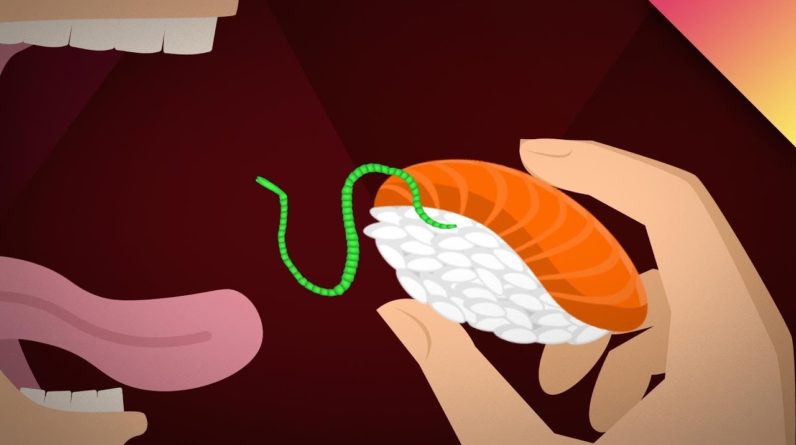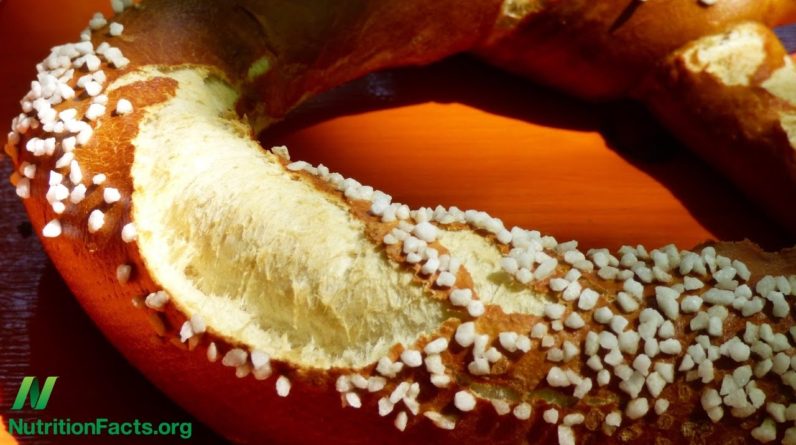
Hey smart people, Joe here. What do poke, sushi and sashimi, and all these
dishes have in common? They’re delicious. They’re made with raw fish. And they could all give you parasites. Yep. The ocean is a parasite playground. That warning about raw or undercooked fish
at the bottom of every menu? It’s there for a reason. At least 15,000 different species of wormy
parasites use fish as a host. Raw fish dishes like sashimi are, well…
raw. They’re never cooked–which means any parasites
or parasite eggs in the fish can end up in our tummies. In case you’re wondering, let me make this
next part extra clear for ya: Parasites are so common in fish, if you’ve eaten raw fish
more than a few times, you’ve almost definitely eaten a parasite egg.
The real question is… did it hatch? [OPEN] Ok, so Anisakis is one of the parasites you
could get from eating sashimi. One investigation found that 10% of salmon
sushi sampled from Seattle restaurants contained dead Anisakis worms. Now, if that raw fish is treated according
to regulations–previously frozen for at least 7 days at -20 degrees C — then the parasites
and the eggs should all be dead. But that means you did still definitely eat
them. If the fish isn’t frozen correctly or it’s
eaten fresh, viable worms and eggs can make it into your gut. Like all parasites, these worms live in a
carefully evolved life cycle: The eggs are released into the ocean through marine mammal
poop, which are then eaten by crustaceans, which are then eaten by fish. When people eat this fish, we interrupt this
natural cycle, and the nematode worm larvae can take up residence inside our throat, stomach,
or intestinal lining instead. On rare occasions people report feeling a
tingling after eating sushi–that’s not the wasabi people, it’s worms! Well, it’s probably wasabi. But it COULD be worms! Of course parasites don’t have to be worms,
they can come in a ton of forms from microbes to ticks to plants to fungi.
Humans have recognized the weirdness of parasites
for a long time, from the ancient Greeks and Egyptians to the Chinese. The first written records show up on medical
papyruses from ancient Egypt, and we’ve found parasite eggs in actual 3000 year old
mummies. They’re even described in the Bible. The 'fiery serpents' mentioned in the Old
Testament are thought to be an early description of a painful condition caused by Guinea worms. But back then “doctors” didn’t understand
how people actually got parasites.
In the 17th century, folks thought parasites
just spontaneously generated in the human body because they never saw the worms go in,
they only ever saw the worms come out–if you know what I’m sayin. Of course now we know parasites don’t have
to go in as whole worms. You only need to eat their eggs. That’s how the life cycle of another ocean
parasite goes: Euuuu’ve gotta be kidding me, I can’t say that name. THAT thing resides in salt marshes off the
California coast. It gets passed around by three different hosts:
Birds poop out the parasite eggs, and the eggs get eaten by horn snails. Then the parasite castrates the snail and
reproduces inside it. Then, the parasite swims out of the snail,
and into the gills of the unsuspecting California Killifish. It digs through the gills and into the fish’s
head, where it weaves a little parasite carpet over the little fish’s brain. Killifish that are infected with parasites
jerk around and swim near the surface of the water, which make birds THIRTY times more
likely to snatch that killifish up for a snack than one that isn’t infected with parasites.

The parasites are promoting their own survival…
by getting the fish eaten. Finally, after the fish get munched, the parasites
burst out into the birds’ guts and the cycle starts all over again. Now, that is the circle of life. Ok, so fish are one thing. But parasites are everywhere, land, sea, even
air–they make up as many as half of all animal species. Scientists think more than 200 different forms
of parasitism have evolved independently from one another. It’s difficult to even estimate the number
of parasites on Earth because they can come in so many forms. From the beginning of multicellular life on
Earth, parasites have been locked in quiet evolutionary arms races with almost everything
living in their environment. Hosts and parasites always trying to stay
one step ahead of each other. And here’s the thing: Even if you’ve never
gotten sick from eating worm-infected sushi, parasites have impacted your life. Human DNA is full of battle scars from our
species’ past run-ins with parasites. One of the most famous and nasty parasites
out there is Plasmodium vivax, carried by mosquitoes, it’s responsible for millions
of cases of malaria a year.
Today, a whopping 99% of people living in
sub-Saharan Africa have a specific type of a protein receptor on their red blood cells
that doesn’t allow the parasite to gain entry. They evolved a natural malaria parasite defense! We think this change in the genome only took
8000 years to become widespread in that region, meaning it must have been much easier to survive
in the environment with that variant of the gene than without it. Parasites cause us harm, so the simple and
obvious answer is that getting rid of them is a good thing, but biology is rarely simple
and obvious.
Preserving parasites could be more important
than we realize. Let’s return to the California salt marshes
and see what happens if we disrupt the parasite balance. Snails that aren’t infected reproduce super
quickly. This could lead to fewer plants, fewer fish,
less for birds to eat… by messing with a parasite, we’ve broken the ecosystem. This is important because parasites are actually
at risk–climate change could cause the extinction of one third of them by 2070. Parasites are often gross, but they are critical
to keeping balance in ecosystems–and we aren’t even close to knowing how diverse the parasite
world really is. The conservation of parasites doesn’t inspire
a warm and fuzzy feeling. But it’s just as important to the environment
that we save not only the whales… but also the worms inside their guts.
Sushi anyone? Stay curious..







